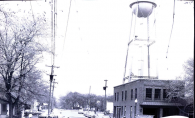Many will remember Thursday, September 4, 1941, as the day disaster struck White Bear. A cyclone tore through the downtown and adjacent residential area during midday, when many were not at home. Schoolchildren who had walked home for lunch were headed back to class as the storm struck in the vicinity of Webster School.
The impact to homes and other buildings was significant; those that escaped total destruction suffered some form of damage. Cleanup around town took more than a week, and power and telephone lines were down for days while crews worked to get everything up and running.
The storm seemed to form on the south end of town and begin its destructive path near Jantzen’s Cabin Camp, which sat on the west edge of Goose Lake. From there, it traveled north and slightly east across the bay of White Bear Lake, and headed roughly up Stewart Avenue before continuing north toward White Bear Beach.
Response to the needs of those injured or in need of assistance was almost immediate. White Bear police officer Art Long was immediately on the scene taking the injured to the hospital and patrolling the neighborhoods for those who might try to take advantage of open homes and stores. Fire Chief Al Podvin quickly realized phones and fire alarm systems were down; he ordered firefighters to the fire hall to be on call in case an emergency came in.
Within a few weeks most services were back to normal around town. However, for those with damages, the impact was felt for a long time.









